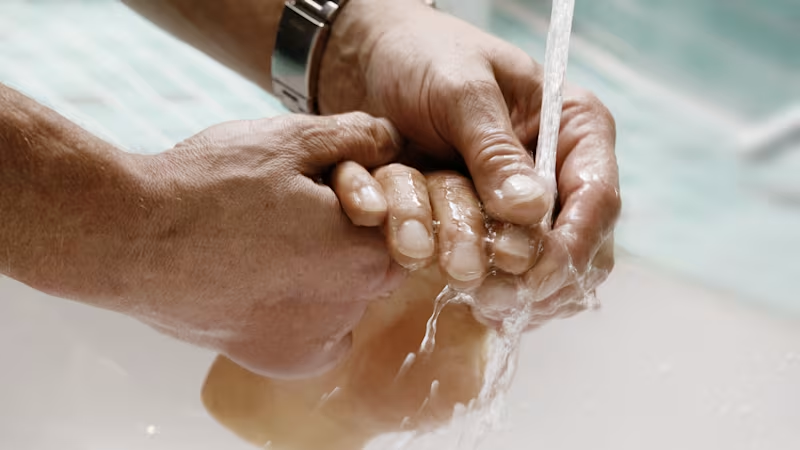


Living with a finger amputation
What happens before a finger amputation? What happens afterwards? What will my life be like with a prosthesis? People affected by an amputation ask themselves these and many other questions. They can find answers here.
What happens before a finger amputation? What happens afterwards? What will my life be like with a prosthesis? People affected by an amputation ask themselves these and many other questions. They can find answers here.
Finger/partial hand amputation – what now?
Our hands combine sensory, motor as well as social functions. They are always visible – and are a way of introducing ourselves when giving a first impression: Are our hands clean? Are the fingernails cared for? We often shake hands when greeting each other. Concluding a contract is sealed with a handshake. As an amputee, how do I handle such situations with my amputation?
Today, amputated limbs can be replaced with a hand and finger prosthesis. These prostheses are made of silicone and look deceptively real. A silicone hand or finger prosthesis often goes unnoticed at first in everyday life.
Causes for the amputation
What amputation types are there?
Our hands enable us to execute a variety of complex movements, so we use our fingers and hands for many different purposes every day.
Your surgeon will do everything in their power to preserve as much of your hand as possible. Hand and finger amputations are performed at various heights called amputation levels.
The extent of the injury determines the amputation level. When the entire hand has to be amputated at the wrist, this is known as a hand amputation. A finger amputation is when one or more fingers have to be amputated. Any amputation between a finger and hand amputation is a partial hand amputation.
The new hand
After an amputation, modern orthopaedic technology makes it possible to treat the affected hand with a hand, partial hand or finger prosthesis.
The design of your hand or finger prosthesis depends on the amputation level: if the residual limb length is at least 2 cm after a finger amputation, fitting a silicone finger prosthesis is generally possible. If the residual limb is shorter or part of the hand is missing, a silicone partial hand prosthesis is used.
Incidentally, the number of amputated fingers has no influence on the decision to carry out a fitting with finger prostheses or a partial hand prosthesis.
It’s impossible to make a general prediction about which functions your hand will be able to perform again with a prosthesis, or what your hand will look like after an amputation. The residual limb situation varies considerably between individuals. Questions regarding this are answered during an individual consultation and in the trial phase of treatment with a prosthesis.

What happens after the amputation?
Further treatment begins directly after the amputation. The wound has to heal and the residual limb must be shaped.
Qualified personnel take care of post-operative treatment of the residual limb with regular changes of the compression bandages. The goal is to eliminate the accumulated blood around the wound and the retained tissue fluid more quickly, reducing the residual limb volume. Slight targeted pressure is applied with compression bandages to also compress the residual limb as far as possible. If the residual limb is to be subsequently fitted with a silicone prosthesis, using silicone compression aids at this point is recommended.
It’s impossible to predict how much time it will ultimately take for the wound to heal. The wound healing period varies considerably and is also influenced by other factors, such as accompanying illnesses (diabetes for instance) or nicotine consumption.
What are all the things I can do with a hand or finger prosthesis?
What are the benefits of a finger/partial hand prosthesis made of silicone?
Your silicone prosthesis fulfils numerous technical and social functions. The following is a summary of what a silicone prosthesis has to offer:
Secure fixation
Very comfortable to wear
Thin socket brims
Good skin compatibility
Anatomically correct shape
Aesthetic design
Easy handling
Easy care
The prosthetic socket provides secure fixation and is very comfortable to wear. The socket forms the link between your residual limb and the prosthesis. It is custom fabricated for your residual limb. The prosthetic socket uses a vacuum to create a firm, direct connection between the prosthesis and your residual limb. As a result, the finger prosthesis is reliably fixed to the residual limb in any position and during all grasping movements.
At the same time, the custom fabricated prosthetic socket is very comfortable to wear thanks to the use of materials with different degrees of hardness. This is particularly advantageous for users with problem areas on their residual limb – for example, when the skin on the residual limb is especially sensitive, or the end of the residual limb is bony.
While this may sound strange, the aesthetics as such represent a function: when you accept how your hand looks, you won’t hide it in your pocket. The anatomically correct shape and colour of the hand are restored to look deceptively real, ensuring relaxed interactions with others – a key aspect in helping you integrate into everyday social and professional life.










